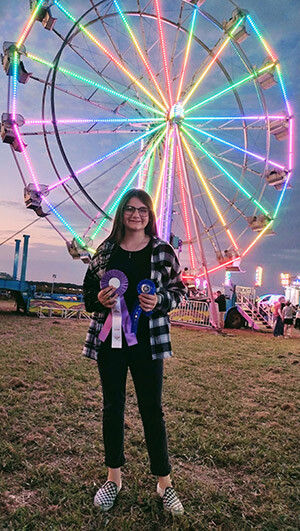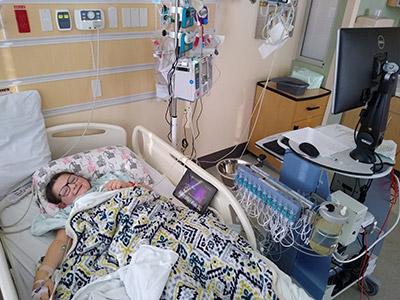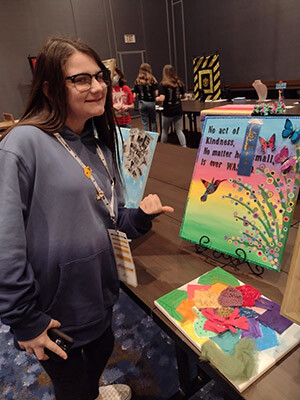
Adalynn
Perseverance pays off
Baking runs in Adalynn’s family. Her great-grandmother made cakes for a living and Adalynn keeps the tradition alive by baking her signature carrot pecan cake.
“I’ve won Best-in-Show at the Fannin County Fair baking competition for five out of the last seven years,” said Adalynn.
Baking is not the only thing Adalynn excels at. She’s also incredibly active and plays volleyball, softball and tennis. And she’s a killer disc and shot put thrower in track.

If you met her, you wouldn’t know that anything is physically wrong with Adalynn. But she often experiences terrible abdominal pain and cramping. And, as a freshman in high school, she sometimes has to leave parties or practices early to go home every evening, hook up a tube to a “button” in her abdomen, and flush out her colon every night for at least an hour.
Britnee, Adalynn’s mom, said, “So many people take going to the bathroom for granted, but Adalynn cannot go on her own.”
A lifelong struggle
Adalynn has struggled with constipation since she was born.
As a baby, doctors and her parents tried every baby formula to see which one might help most. None of them did anything to regulate her digestive system.
Right before her 3rd birthday, she became extremely ill. “She was vomiting and had diarrhea for 21 days straight,” said Britnee.
There were no good explanations – just more tests and prescriptions for every possible laxative – in every possible combination. Her doctors at the family's local hospital determined Adalynn needed more specialized pediatric diagnostic and treatment expertise. They referred Britnee and her toddler to Children's Health.
At Children’s Health, the gastroenterology team did more testing and more prescribing of every laxative combination available. Then, at age 6, Adalynn started vomiting food that she'd eaten three to four days earlier. Testing revealed that she had gastroparesis, or paralysis of her stomach. But the cause of the gastroparesis was extreme constipation. This time, they prescribed medications for Adalynn to take before eating to help food move through her digestive system.

Finally, at age 9, Adalynn and her mom were finally able to get more clarity. Adalynn had become critically ill again and was admitted to the hospital. Her care team recommended her care be taken over by a new motility specialist at Children’s Health (motility is a unique subspecialty of gastroenterology specializing in how food moves through the colon). A colonoscopy still pointed to extreme constipation. But the motility specialist decided the only way to get a clear picture of Adalynn’s condition was to do a manometry test, a highly-specialized, lengthy test to more closely examine Adalynn’s colon.
The manometry test, which required Adalynn to lay flat for nearly 48 hours, used sensors placed along the colon to see how Adalynn’s entire colon reacted to certain foods she ate. The test revealed a new, rare diagnosis – colonic dysmotility, which has no clear cause, and means Adalynn’s colon does not contract and move waste along like other people’s colons.
The test was very difficult for Adalynn, but Britnee was so relieved to have a more accurate diagnosis. Her new diagnosis is what started discussions about a cecostomy – the procedure that created an opening for Adalynn’s “button” that allows her to do her daily flush.
“Every hospital needs Child Life”
Being repeatedly poked, prodded and tested for so many years – without yielding clear cut answers or solutions – has been anxiety-provoking for Adalynn.
Britnee remembers how severe the anxiety was when Adalynn was younger. “Sometimes, they’d need to get an IV in. But she was constipated, dehydrated and vomiting. They’d have to wrap her up in a sheet, like a burrito, to get enough control to put in the IV,” she says.
Programs like child life – which provide coping strategies and help make life easier for those experiencing the unthinkable – are offered throughout the hospital at no cost to patient families, thanks to the generous support of philanthropic gifts. They’re one of the resources that makes the holistic care we provide patients and families at Children’s Health unique.
The child life specialists make me feel more comfortable, more at home. They’ve taught me it’s OK to be scared and also to tell the doctor and nurses what I like or don’t like.
— Adalynn
Quality of life in the face of uncertainty
Adalynn’s inner strength does not let having her “button” stop her from living a full, busy life. Her friends help keep her spirits up and always check on her when she’s sick.
Her volleyball coach has taught her an alternate way to dive for the ball, and she wears extra protection for her “button” when she plays catcher on her softball team. And, during her nightly flushes, she’s discovered a love of drawing. Last year, her artwork won first place at her annual school art competition.

Britnee is proud of the way her 14-year-old daughter has taken charge of her difficult diagnosis and care, and shown so much courage. She knows that being under the care of motility specialists at Children’s Health – the only hospital in the state to offer such care for children – has helped her live as normal a life as possible. And having her “button” has been life-changing.
“Before her cecostomy surgery, Adalynn would swallow 16 capfuls of Miralax in three hours and still not be able to go to the bathroom. We had to be admitted to the hospital for everything and Adalynn always needed feeding tubes put down her throat,” Britnee said. Now, we don't have to go to the hospital for clean-outs. We can do everything through her button at home.”
The family is now working closely with motility specialist Alejandro Llanos Chea, M.D., Pediatric Gastroenterologist and Assistant Professor at UT Southwestern Medical Center, to use more advanced manometry tests to better understand which parts of Adalynn’s colon work and which medications and foods elicit the best response.
This will help them determine if having part of her colon removed or having an ileostomy (an external bag that collects waste) might be a better long-term solution for Adalynn.
“Dr. Llanos has helped us breathe again because he’s so aware, understanding and knowledgeable. He can help us better figure out what might actually give her the most relief,” said Britnee.
Britnee credits Children's for giving her daughter the quality of life she now has and she knows that behind their doctors is a community of donors who believe in the importance of every child receiving the best possible care, no matter their diagnosis.
“Before Children's Health, Adalynn was sick and throwing up and nobody could explain it. The doctors at Children’s Health did the research and testing and kept fighting to figure out why she was getting so sick. We would not be here if it was not for Children's Health.”
Adalynn hopes one day she won’t need her button. But, in the meantime, with the support of her friends, family, and care team, she’s got cakes to bake, pitches to catch and balls to spike.
Meet more Children's Health patients
Read more patient stories like Adalynn's and meet our Patient Ambassadors to learn how Children's Health makes life better for children.
Kids count on us. We count on you.
Give to support innovative research, lifesaving treatments and compassionate care.
Did you enjoy this story?
If you would like to receive an email when new stories like this one are posted to our website, please complete the form below. We won't share your information, and you can unsubscribe any time.

